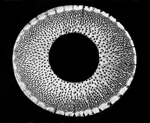|
1628: The Kaidō honsoku 'Fuke-komosō' Credo Version 1
海道本則
Web page updated as of January 16, 2024.
Document dated 1628, March 26th - Kan'ei 5, Mid-Spring, 21st day.
Acknowledgements:
Cordial thanks to Mr. Yamakawa Sōkyū,
山川宗休,
Kōkoku-ji near Yura in Wakayama Prefecture,
Mr. Ōno Osamu,
大野治,
the Central Public Citizen's Hall in Yura,
as well as Mr. Simura Satosi,
志村哲,
and the late Mrs. Tsukitani Tsuneko,
月溪恒子,
both Ōsaka University, for their generous helping me with - and acknowledging - this research project of mine,
back in the 1980s and later on, respectively.
As of recently, very warm thanks to Mr. Shawn Renzoh Head for highlighting and reading aloud the Kaidō honsoku document in a Youtube video of his titled
Kaido Honsoku:Shakuhachi Document Reading
NB: Also, do read about 'Kaidō honsoku' copy versions 2 and 3 under the entries "c. 1640?" and "1650s?":
c. 1640?: The Kaidō honsoku "Version 2" Copy
1650s?: The Kaidō honsoku "Version 3" Copy
KAIDŌ HONSOKU
This very important 'Fuke-Komosō' text is also being referred to and alternatively titled and recognized as:
暮露薦僧本則 - BORO KOMOSŌ HONSOKU
暮露虚無僧本則 - BORO KOMUSŌ HONSOKU
暮露の手帳 - BORO no TECHŌ
暮露の手記 - BORO no SHUKI
However: 'Kaidō honsoku',
海道本則,
may actually never have been the true "title" of the original document at all ...
KAIDŌ HONSOKU FUKE-KOMOSŌ LOOK-a-LIKEs:
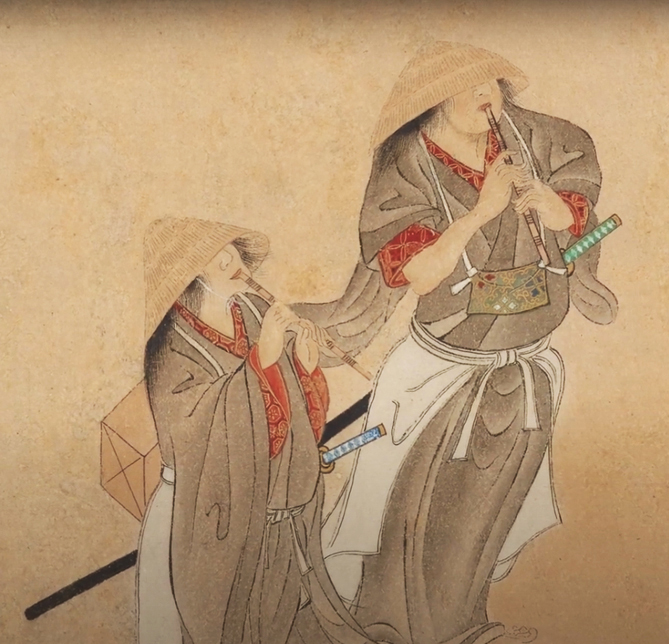
Two 'Fuke-komosō' pictured by Iwasa Matabei, no later than 1630.
Now c/o the Freer Gallery of Art, USA
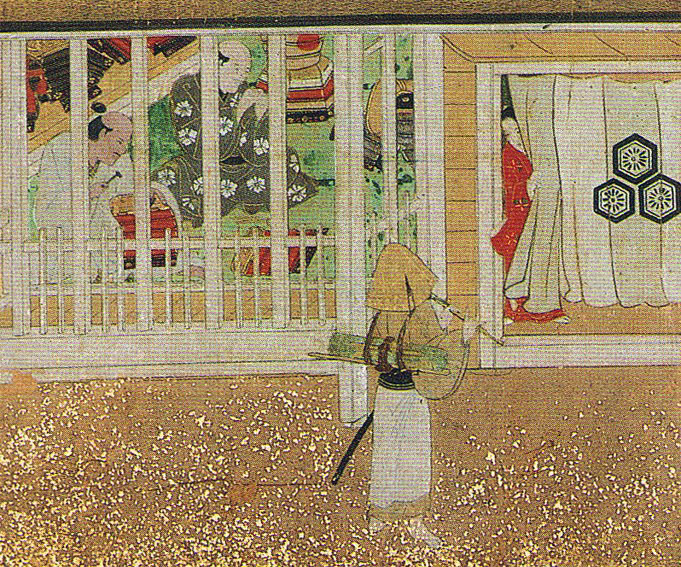
Yet unidentified, so far undated, really early 17th century 'Komosō' picture.
Apparently part of a rather typical Azuchi-Momoyama Period gold-leaf decorated folding screen
with everyday scenes, dating from the early 1600's
First presented on Dean Delbene's Myōan Blogspot site with no documentation/date
The really mysterious 'Komosō' Shakuhachi document Kaidō honsoku was - apparently - created, and dated -
by one or more anonymous Fuke-komosō "mat monks" in 1628, i.e. the early Edo period.
Although the original document scroll has been reported missing - if not downright stolen, and purged!? -
from its former owner and caretaker, the Rinzai Zen temple Kōkoku-ji in Yura, Wakayama Prefecture,
fortunately, prior to the loss, the text of the document was carefully copied and published in several reprints,
and thus preserved, in a way so as to be studied in rather some detail, even after the alleged disappearance of the original manuscript itself.
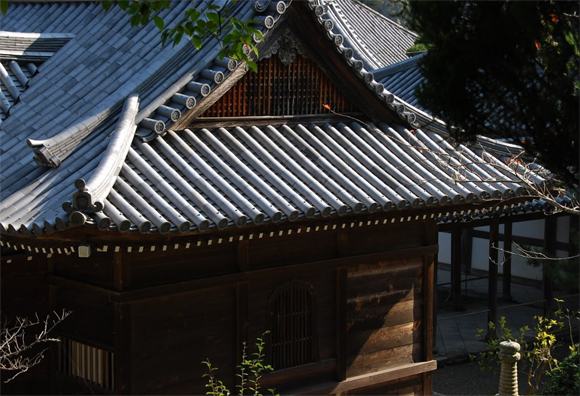
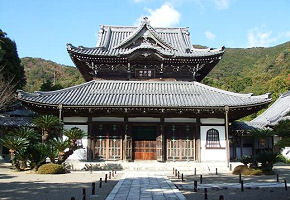
Left: The Kōkoku-ji 'Sho-in' library building. Source: Google Maps, photo by KY SG.
Right: The Kōkoku-ji Main Hall. Source: Wakayama TV website
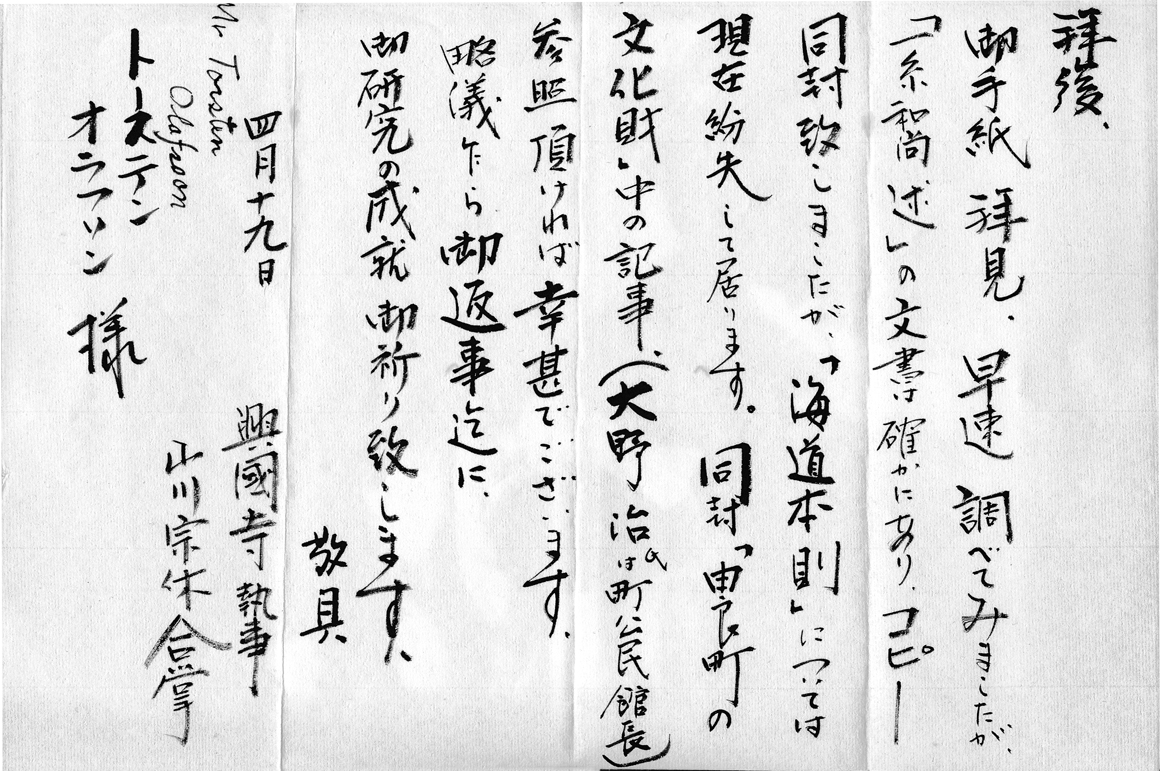
Scanning of the Kōkoku-ji head librarian Yamakawa Sōkyū's
April 19, 1985, letter to Torsten Olafsson.
In this letter Mr. Yamakawa explains that while he actually does enclose a complete
xerox copy of Isshi Bunshu's letter (cols. 3-4 from the right),
the 1628 'Kaidō honsoku' document "has now gone missing": 'genzai funshitsu shite orimasu,'
現在紛失して居ります (cols. 4-5).
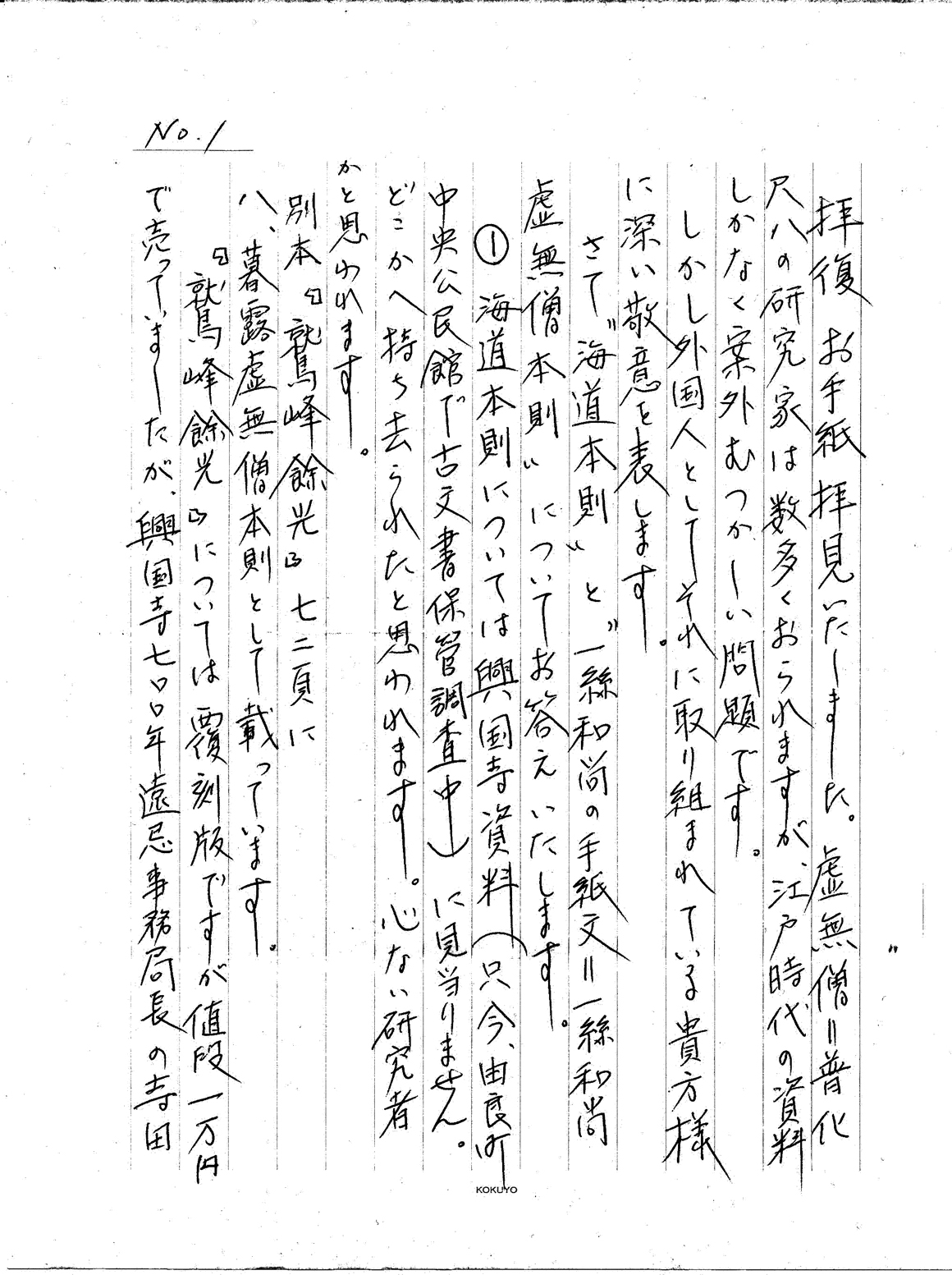
In Spring, 1986, when I was communicating Mr. Ōno Osamu, then head of the Yura City Central Public Citizen's Hall's archives,
Mr. Ōno sent me this kind May 25 letter in which he states regarding the missing 'Kaidō honsoku' document scroll that,
"I think it has been taken away. Probably by a mindless researcher ... ?",
'Dokoka e mochisarareta to omowaremasu. Kokoro nai kenkyūsha to omowararemasu,'
どこかへ持ち去られたと思われます。心ない研究者かと思われます
(page 1 of 3 in all, cols. 10-11 from the right).
The "official" and fully authoritative edition of the preserved version of the Kaidō honsoku document, dated 1628,
was first published in 1938 and re-published in 1981 by the Kōkoku Temple in Yura, Wakayama, then compiled and edited by Mori Hikotarō.
Here you see a complete scanning of the very book pages in question:

'Kaidō honsoku' headlines and notes in Mori, 1981, Part 2, p. 72.
Now, as we are unable to study the original document scroll, it is of essential importance and significance to note that the editor, Mori Hikotarō,
added the comment "written differently",
'i-hitsu',
異筆,
to the right of the very opening paragraph, thus implying that that sentence,
or "headline"?, must have been added to the original 'Kaidō honsoku' document scroll sometime after 1628.
Even the following sentence mentioning " ... issued from Yura in the Kii Province" may very well be a later addition to the original scroll, or to even some copy of it.
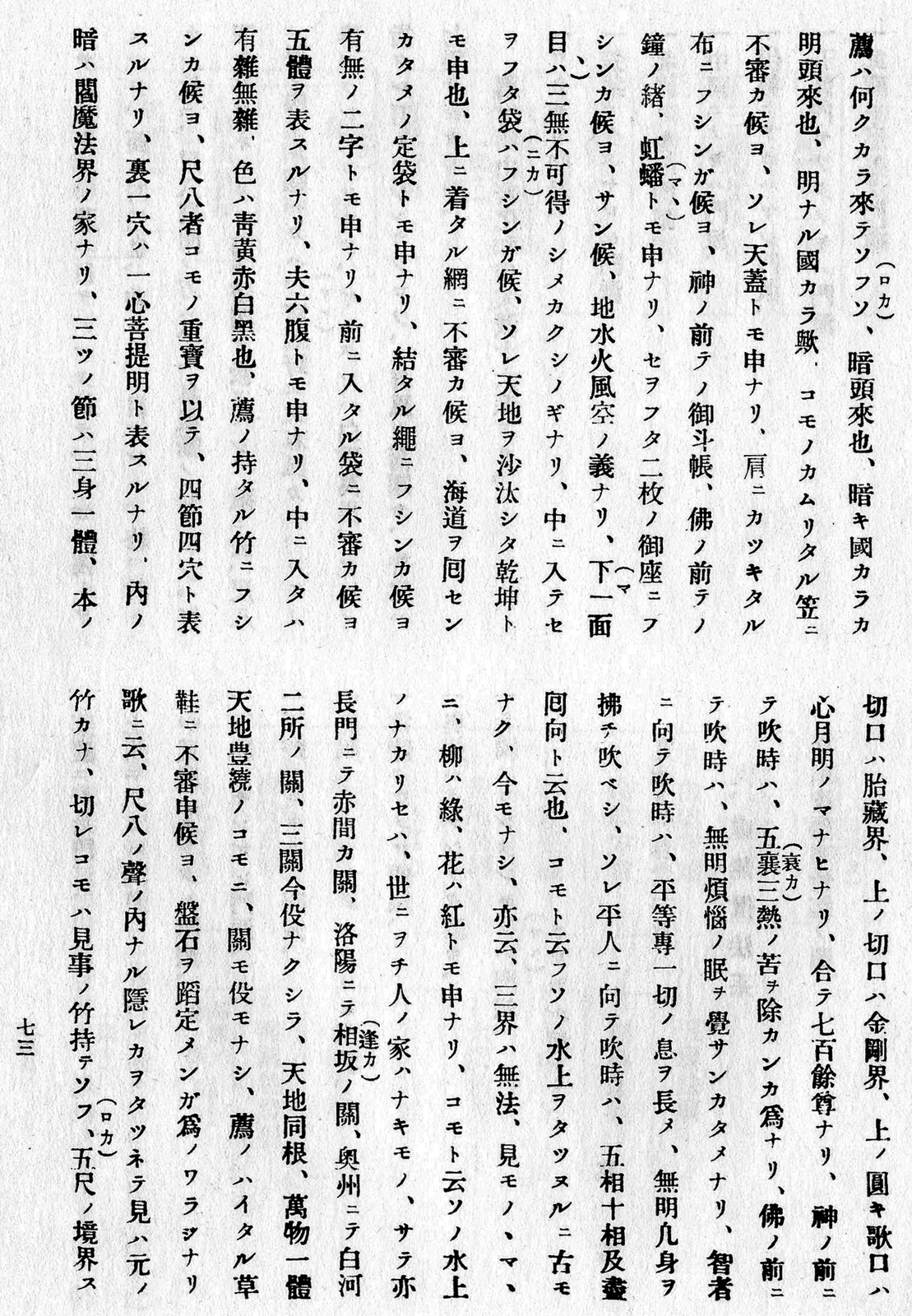
'Kaidō honsoku' text in Mori, 1981, p. 73
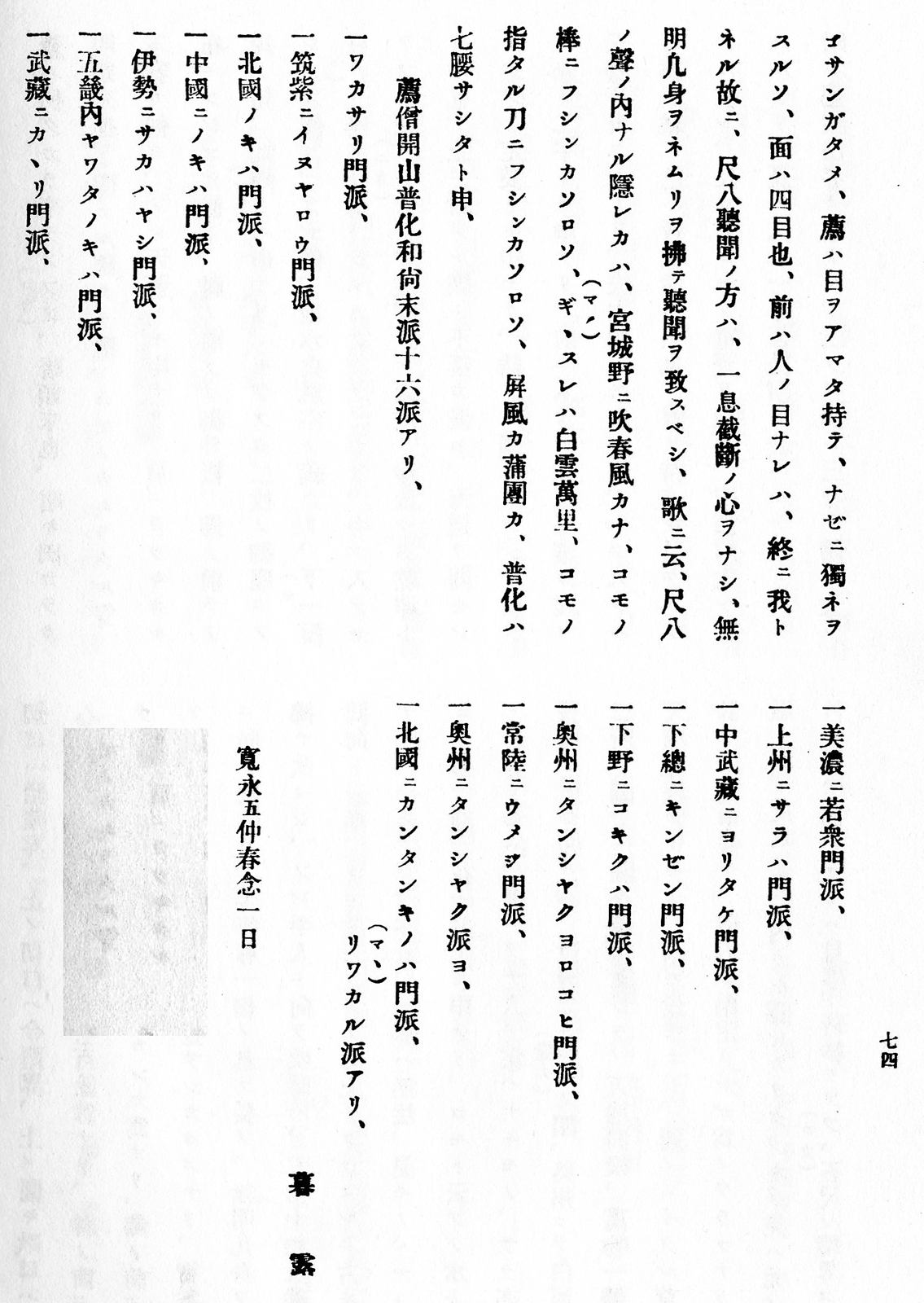
'Kaidō honsoku' text in Mori, 1981, p. 73
BIBLIOGRAPHY
The Kaidō honsoku is available in full or partial reprint in at least these ten - 10! - Japanese publications:
1936, Shōwa 11:
Kōya-san bunsho Vol. 9, pp. 261-264.
1937:
Nakatsuka Chikuzen: 'Fuke-shū no seiritsu.'
In Sankyoku No. 188, Tokyo, Nov. 1937, pp. 20-31.
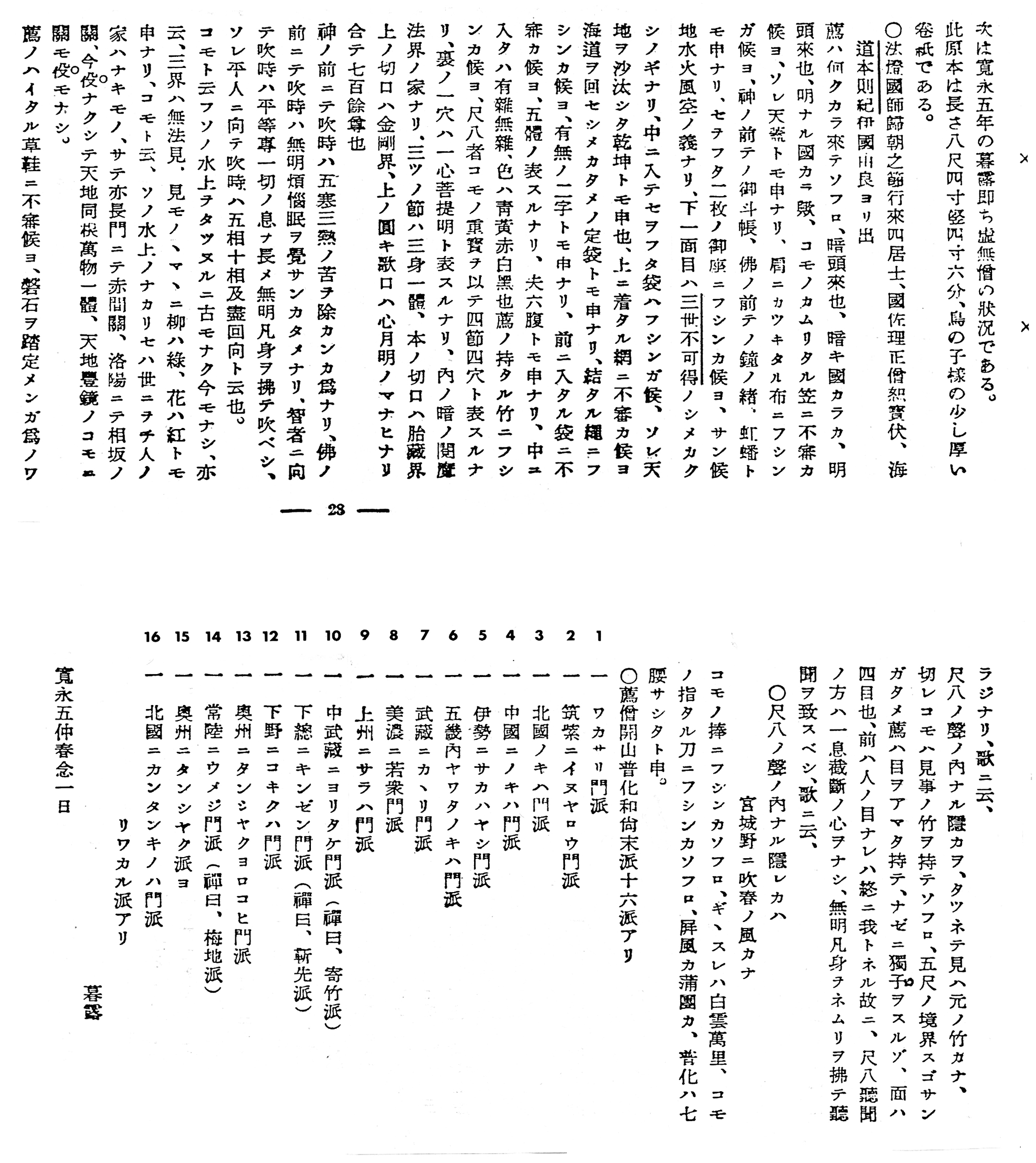
'Kaidō honsoku' text in Sankyoku 188, November, 1937
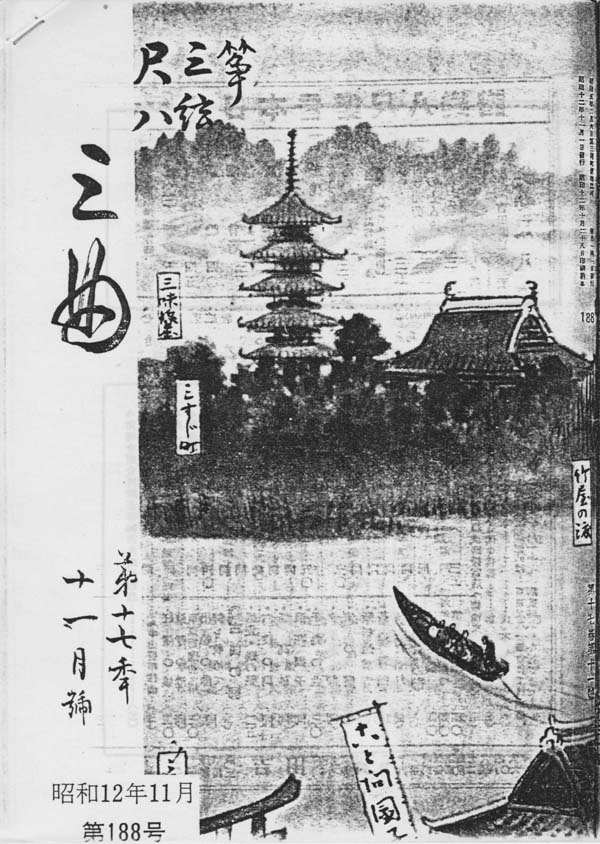
'Sankyoku' magazine No. 188, November 1937, cover front
1938:
Mori Hikotarō, editor: Shūhū Yokō.
Publ. by the Kōkoku-ji, Yura, Wakayama Prefecture, Japan, 1938/1981, pp. 72-74.
1979:
Nakatsuka Chikuzen: Kinko-ryū shakuhachi shikan.
Nihon Ongaku-sha, Tokyo, 1979, pp. 271-273.
1981:
Mori Hikotarō, editor: Shūhū Yokō.
Re-publ. by the Kōkoku-ji, Yura, Wakayama Prefecture, Japan, 1938/1981, pp. 72-74.
1981:
Kowata Suigetsu, editor: Yamamoto Morihide's 'Kyotaku denki kokujikai.'
Modern version published by Nihon ongaku-sha, Tokyo, 1981, pp. 186-188.
1994:
Hosaka Hiro'oki: 'Jūshichi seiki ni okeru komusō no seisei: boroboro,
komosō to no idō to 'kou' kōi no arikata.'
Printed in: Mibunteki shūen, Buraku mondai kenkyō shuppan-bu, 1994, pp. 190-193.
1997:
Takeda Kyōson: Komusō: sei to zoku no igyōsha-tachi.
Sanitsu Shobō, Tokyo, 1997, pp. 173-178.
2005:
Yamaguchi Masayoshi: Shakuhachi-shi gaisetsu.
Shiryō to tomo ni tadoru shakuhachi no rekishi.
Shuppan Geijutsu-sha, Tokyo, 2005, pp. 123-124.
2021, November 12:
Shakuhachi-kataha website, web page dated November 12, 2021.
Active link:
Shakuhachi-kataha, Nov. 12, 2021
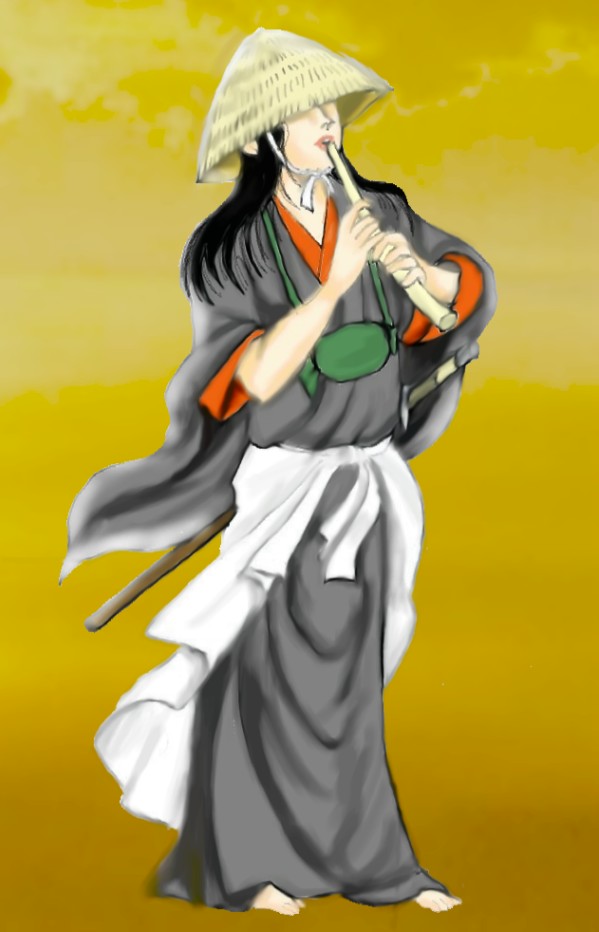
Very early Edo Period (early 17th century) 'komo-sō',
薦僧/菰僧, style mendicant miyo-giri shakuhachi,
三節切り尺八, flute player
This is a modern Japanese painting depicting a very early 17th century
'komosō', "mat monk" - NotaBene not a 'komusō'!
Website source: blog.zaq.ne.jp/randokku
ENGLISH TRANSLATION of the KAIDŌ HONSOKU
Here follows my translation into English, based on the version which was originally presented in my M.A. thesis in Japanology
and accepted by the University of Copenhagen, Eastasian Institute, in 1987, as well as the Tai Hei Shakuhachi edition of the work
which was published internationally in 2003 by Monty H. Levensom, Taihei Shakuhachi, Willits, CA, USA.
The presentation of the translation has once more been updated as of November 24, 2018.
All paragraphs have been renumbered:
The renumbered paragraphs "00" &: *0": See notes after the translation
1:
薦ハ何クカラ来テソフソ(ロ?)、
暗頭来也、暗キ國カラカ
明頭来也、明ナル國カラ歟、
Where from does the Komo come?
Fuke said,
‘The Dualistic Notion of "Darkness" appears ... ’
Does he come from the Realm of Obscurity?
Fuke said,
‘The Dualistic Notion of "Brightness" appears ... '
Does he come from the Realm of Clarity?
2:
コモノカムリタル笠ニ、不審カ候ヨ、
ソレ天蓋トモ申也、
Oh, how mysterious is the basket hat that the Komo is wearing on his head!
It is also called the ‘Tengai’.
3:
肩ニカツキタル布ニフシンカ候ヨ、
神ノ前テノ御斗帳、
仏ノ前テノ鐘ノ緒、
虹蟠とも申なり、
Oh, how mysterious is the piece of cloth that he carries over his shoulder!
That is the ‘Dots-and-Cross’ patterned curtain in front of the Shintō Dëity and the Bell
String in front of the Buddha, and it is also called the ‘Rainbow Coil’.
4:
セヲフタニ枚ノ御座ニフシンカ候ヨ、
サン候、地水火風空ノ義ナリ、
下一面目ハ三無不可得ノシメカクシノギナリ、
Oh, how mysterious is the double-leaf, fine straw mat that he carries on his back!
It represents the Tripartite Climatic Periods and the Five Elements: Earth, Water, Fire,
Wind, and Space.
The first layer signifies the Total Concealment of the Ungraspability of the Three
Existences: Past, Present, and Future.
5:
中ニ入テセヲフタ袋ハフシンカ候、
ソレ天地ヲ沙汰シタ乾坤トモ申也、
How mysterious is the case that he carries on his back, inside the rolled up straw mat!
It is also called the ‘Kenkon’ which proclaims the Interrelatedness of Heaven and Earth.
6:
上ニ着タル網ニ不審カ候ヨ、
海道ヲ囘センンカタメノ定袋トモ申ナリ、
Oh, how mysterious is the net that he has wrapped around the things!
It is called the ‘Prescribed Bag’ for accomplishing an exhaustive roundtrip
through all the provinces.
7:
結タル縄ニフシンカ候ヨ、
有無ノニ字トモ申ナリ、
Oh, how mysterious is the rope with which everything is tied together!
It is also called the ‘Two Concepts of Being and Non-Being’.
8:
前ニ入レタル袋ニ不審カ候ヨ
五體ヲ表スルナリ、
夫六腹トモ申ナリ、
中ニ入タハ有雜無雜、
色ハ青黄赤白黒也、
Oh, how mysterious is the purse that he carries placed on his chest!
It expresses the Totality of the Human Body. It is also called the Six Internal Organs.
It contains miscellaneous things, their colors being bluish-green, yellow, red, white, and black.
9-a:
薦ノ持タル竹ニフシンカ候ヨ、
尺八者コモノ重寶ヲ以テ、
四節四穴ト表スルナリ、
裏一穴ハ一心菩提明ト表スルナリ、
内ノ暗ハ閻魔法界ノ家ナリ、
三ノ節ハ三身一體、
本ノ切口ハ金剛界、
上ノ圓キ歌口ハ心月明ノマナヒナ、
合テ七百餘尊ナリ、
Oh, how mysterious is the bamboo flute that the Komo carries!
The shakuhachi is the principal treasure of the Komo and it represents the Four Seasons,
likened to the four finger holes in the front.
The single finger hole on the back expresses the Clarity of the Enlightened, Adual Mind.
As for the darkness of its interior, that represents the Realm of Jurisdiction of the King of
Hell, Judge of the Dead.
The three nodes represent the Oneness of the Three Bodies, the lower opening the Womb
World, the upper opening the Diamond World, and the crescent-shaped mouthpiece above
teaches the Clarity of Absolute Reality.
The shakuhachi is precious beyond limit.
9-b:
神ノ前ニテ吹時ハ、
五衰三熱ノ苦ヲ除カンカ爲ナリ、
佛ノ前ニテ吹時ハ、
無明煩悩ノ眠ヲ覺サンカタメナリ、
智者ニ向テ吹時ハ、
平等専一切ノ息ヲ長メ、
無明凡人ヲ拂テ吹ベシ、
ソレ平人ニ向テ吹時ハ、
五相十相及盡囘向ト云也。
When the Komo plays in front of a Shintō Dëity, it is to end the Suffering from the Five
Types of Decay and the Three Fevers.
When the Komo plays in front of an image of the Buddha, it is to awaken from the
Drowsiness of Earthly Desires Originating in Illusion.
When the Komo plays for educated persons, he should prolong his breathing in constant
concentration and blow so as to drive away the Mediocre Body Originating in Illusion.
When he plays the shakuhachi for ordinary, uneducated persons, it is to explain all the
Schools of Buddhism as well as performing all of the Buddhist Ceremonies.
10:
コモト云フソノ水上ヲタスヌルニ
古モナク、 今モナシ、
亦云、 三界ハ無法、
見モノノママニ、
柳ハ緑、花ハ紅トモ申ナリ、
コモト云ソノ水上ノナカリセハ、
世ニヲチ人ノ家ハナキモノ、
サテ亦長門ニテ赤間カ關、
洛陽ニテ相坂ノ關、
奥州ニテ白河二所ノ關、
三關今役ナクシラ、
天地同根、萬物一體
天地豊繞ノコモニ、
關モ役モナシ、
If you inquire about the Komo’s place of origin, the answer is:
‘Neither in the Past nor in the Present!’
Or, to put it in the words of Banzan:
‘The Three-fold World is Immaterial!’
Any attempt at answering the question would be just as meaningless as saying ‘the willow
is verdurous, the flower is crimson’!
Instead of a place of origin, the Komo are scattered in the world without such a place to call
home.
And now being deprived of employment anywhere, be it at any of the three barriers of
Akama-ga-seki in the Nagato Province, Ōsaka-no-seki at the [old] capital [Kyōto], or the two checking stations
of Shirakawa in Ōshū, the Komo who abundantly wander the world, to whom Heaven
and Earth have the Same Root and All Creation is One Body, have neither confinements nor
attachments.
11:
薦ノハイタル草鞋ニ不審申候ヨ、
盤石ヲ蹈定メンカ爲ノワラジナリ
Oh, humbly speaking, how mysterious are the straw sandals that the Komo is wearing!
They represent the proper footwear for the steadfast treading his way [on giant rocks]
in the footprints of Banzan and Sekitō.
12):
歌ニ云、
尺八ノ、聲ノ内ナル、隱レカヲ、
タスネテ見ハ、元ノ竹カナ、
切レコモハ見事ノ竹持テソフ(ロ?)、
It is said in a poem that,
‘When you search, and find in shakuhachi sound your refuge,
is that not indeed the essence of bamboo?’
The competent Komo possesses a magnificent piece of bamboo.
13-a:
五尺ノ境界スゴサンガタメ、
薦ハ目ヲアマタ持テ、
ナゼニ獨ネヲスルゾ、
面ハ四目也、
So he may pass through the Five-fold Environments of Karma,
the Komo is observing many precepts
- and therefore he sleeps alone.
The surface has four eyes [or, stitches? - or, the face has four eyes?].
3-b:
前ハ人ノ目ナレハ、
終りニ我トネル故ニ、
尺八聴聞ノ方ハ、
一息截斷ノ心ヲナシ、
無明凡人ヲネムリヲ拂テ
聴聞ヲ致スベシ、
Because the Komo practices celibacy till the end, he shall create a mind of relief and
disconnection in those who listen to his shakuhachi sermons and sweep away the
Drowsiness of Illusion and Mediocrity and bring about Realization.
14:
歌ニ云、
尺八ノ、聲ノ内ナル、隱レカハ、
宮城野ニ吹く、春(ノ)風カナ、
Another poem has it that,
‘Choosing as one’s hermitage the voice of the shakuhachi
is that not the Spring breeze blowing at Miyagi-no?'
15:
コモノ棒ニフシンカソロソ、
ギギスレハ白雲萬里、
How mysterious, indeed, is the Komo’s staff!
If you are doubtful, Setchō said,
‘White Clouds Everywhere!’
16:
コモノ指タル刀ニフシンカソロソ、
屏風カ蒲團カ、
普化ハ七腰サシタト申、
How mysterious, indeed, is the sword that the Komo is carrying!
Even at Banzan’s deathbed Fuke made a somersault over the screen and mattress, it is
being told!
17:
薦僧開山普化和尚末派十六派アリ、
The Komosō founder Priest Fuke’s sect has 16 branches:
17-1:
一 ワカサリ門派、
The Wakazari Branch Sect.
17-2:
一 筑紫ニイヌヤロウ門派、
The Inu-yarō Branch Sect in Tsukushi.
17-3:
一 北國ノキハ門派、
The Hokkoku Noki-ha Branch Sect.
17-4:
一 中國ニノキハ門派、
The Noki-ha Branch Sect in Chūgoku.
17-5:
一 伊勢ニサカハヤシ門派、
The Sakabayashi Branch Sect in Ise.
17-6:
一 五畿内ヤワタノキハ門派、
The Gokinai Yawata Noki-ha Branch Sect.
17-7:
一 武蔵カカリ門派、
The Kagari Branch Sect in Musashi.
17-8:
一 美濃ニ若衆門派、
The Wakashū Branch Sect in Minō.
17-9:
一 上州ニサラハ門派、
The Sara-ha Branch Sect in Jōshū.
17-10:
一 中武蔵ニヨリタケ門派、
The Yoritake Branch Sect in C. Musashi.
17-11:
一 下總ニキンゼン門派、
The Kinzen Branch Sect in Shimōsa.
17-12:
一 下野ニコキクハ門派、
The Kogiku-ha Branch Sect in Shimotsuke.
17-13:
一 奥州ニタンシヤクヨロコヒ門派、
The Tanjaku Yorokobi Branch Sect in Ōshū.
14:
一 常陸ニウメジ門派、
The Umeji Branch Sect in Hitachi.
17-15:
一 奥州ニタンシヤク派ヨ、
The Additional Tanjaku Branch in Ōshū.
17-16:
一 北國ニカンタキノハ門派、
The Kandan-ki no ha Branch Sect in Hokkoku.
リワカル派アリ、
These are the rustic and humble branches.
18:
暮露
Boro — ‘He/they who live(s) like the dew’.
19:
寛永五仲春念一日
Kan’ei 5, Mid-Spring, 21st day.
* Notes to Paragraphs "00" and "0":
The Kaidō honsoku manuscript scroll, as it appears in all of the several known reprints, features at least one headline that, according to the book editor Mori Hikotarō - was written "differently", 'i-hitsu',
異筆,
from the rest of the document:
PARAGRAPH 00:
法燈国師帰朝之節連来四居士、
國佐、理正、僧恕、寶伏。
"When Hottō Kokushi returned to his native country [i.e. Japan], he was accompanied by four Buddhist laymen: Kuo Tsuo, Li Cheng, Tseng Shu & Pao P'u
(in Japanese: Kokusa(ku), Risei, Sōjo and Hōfu)."
PARAGRAPH 0:
海道本則紀伊國由良ヨリ出。
"Kaidō honsoku / The Fundamental Doctrine of Fuke Shakuhachi Itineracy.
[lit.: "Ocean Routes Basic Rules"]
Issued from Yura in the Kii Province."
I am quite convinced that both of these two printed opening sentences must have been added to the original document - or rather, to some or more copies of that - sometime after its initial completion in 1628 and I have therefore omitted the translation of those two particular sentences in the above presentation.
Original translation by Torsten Olafsson, Denmark, 1986-87
Please read more here:
c. 1640?: The Kaidō honsoku "Version 2"
c. 1650s?: The Kaidō honsoku "Version 3"
|

"Kaidō Honsoku"
|
